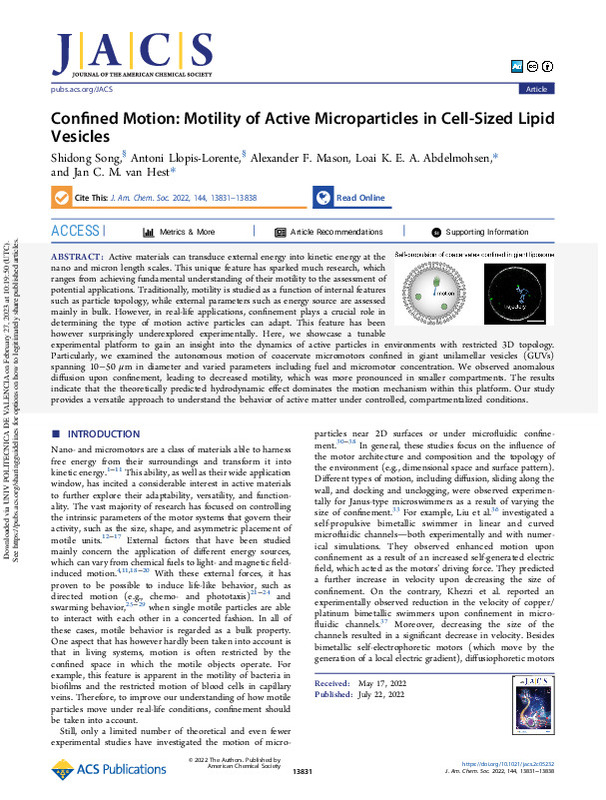JavaScript is disabled for your browser. Some features of this site may not work without it.
Buscar en RiuNet
Listar
Mi cuenta
Estadísticas
Ayuda RiuNet
Admin. UPV
Confined Motion: Motility of Active Microparticles in Cell-Sized Lipid Vesicles
Mostrar el registro sencillo del ítem
Ficheros en el ítem
| dc.contributor.author | Song, Shidong
|
es_ES |
| dc.contributor.author | Llopis-Lorente, Antoni
|
es_ES |
| dc.contributor.author | Mason, Alexander F.
|
es_ES |
| dc.contributor.author | Abdelmohsen, Loai K.E.
|
es_ES |
| dc.contributor.author | van Hest, Jan C. M.
|
es_ES |
| dc.date.accessioned | 2023-09-21T18:06:40Z | |
| dc.date.available | 2023-09-21T18:06:40Z | |
| dc.date.issued | 2022-08-03 | es_ES |
| dc.identifier.issn | 0002-7863 | es_ES |
| dc.identifier.uri | http://hdl.handle.net/10251/196940 | |
| dc.description.abstract | [EN] Active materials can transduce external energy into kinetic energy at the nano and micron length scales. This unique feature has sparked much research, which ranges from achieving fundamental understanding of their motility to the assessment of potential applications. Traditionally, motility is studied as a function of internal features such as particle topology, while external parameters such as energy source are assessed mainly in bulk. However, in real-life applications, confinement plays a crucial role in determining the type of motion active particles can adapt. This feature has been however surprisingly underexplored experimentally. Here, we showcase a tunable experimental platform to gain an insight into the dynamics of active particles in environments with restricted 3D topology. Particularly, we examined the autonomous motion of coacervate micromotors confined in giant unilamellar vesicles (GUVs) spanning 10¿50 ¿m in diameter and varied parameters including fuel and micromotor concentration. We observed anomalous diffusion upon confinement, leading to decreased motility, which was more pronounced in smaller compartments. The results indicate that the theoretically predicted hydrodynamic effect dominates the motion mechanism within this platform. Our study provides a versatile approach to understand the behavior of active matter under controlled, compartmentalized conditions. | es_ES |
| dc.description.sponsorship | The authors would like to acknowledge the support from the Dutch Ministry of Education, Culture and Science (Gravitation program 024.001.035 and Spinoza premium) and the ERC Advanced Grant (Artisym 694120) . A.L.-L. acknowledges the support from the MSCA Cofund Project of Life, which has received funding from the European Union's Horizon 2020 research and innovation program under the grant agreement 847675, and the Maria Zambrano Program from the Spanish Government funded by NextGenerationEU from the European Union. Dr. Bastiaan Buddingh is thanked for useful discussions regarding GUV preparation and handling. Dr. Shoupeng Cao is thanked for providing the azido-functionalized block polymer. We specially thank Prof. Samuel Sanchez for the tailor-made particle-tracking software based on Python. | es_ES |
| dc.language | Inglés | es_ES |
| dc.publisher | American Chemical Society | es_ES |
| dc.relation.ispartof | Journal of the American Chemical Society | es_ES |
| dc.rights | Reconocimiento (by) | es_ES |
| dc.title | Confined Motion: Motility of Active Microparticles in Cell-Sized Lipid Vesicles | es_ES |
| dc.type | Artículo | es_ES |
| dc.identifier.doi | 10.1021/jacs.2c05232 | es_ES |
| dc.relation.projectID | info:eu-repo/grantAgreement/EC/H2020/694120/EU | es_ES |
| dc.relation.projectID | info:eu-repo/grantAgreement/UNIVERSIDAD POLITECNICA DE VALENCIA//MZ//AYUDA MARIA ZAMBRANO DE LLOPIS LORENTE, ANTONI/ | es_ES |
| dc.relation.projectID | info:eu-repo/grantAgreement/EC/H2020/847675/EU | es_ES |
| dc.relation.projectID | info:eu-repo/grantAgreement/OCW//024.001.035/ | es_ES |
| dc.rights.accessRights | Abierto | es_ES |
| dc.description.bibliographicCitation | Song, S.; Llopis-Lorente, A.; Mason, AF.; Abdelmohsen, LK.; Van Hest, JCM. (2022). Confined Motion: Motility of Active Microparticles in Cell-Sized Lipid Vesicles. Journal of the American Chemical Society. 144:13831-13838. https://doi.org/10.1021/jacs.2c05232 | es_ES |
| dc.description.accrualMethod | S | es_ES |
| dc.relation.publisherversion | https://doi.org/10.1021/jacs.2c05232 | es_ES |
| dc.description.upvformatpinicio | 13831 | es_ES |
| dc.description.upvformatpfin | 13838 | es_ES |
| dc.type.version | info:eu-repo/semantics/publishedVersion | es_ES |
| dc.description.volume | 144 | es_ES |
| dc.identifier.pmid | 35867803 | es_ES |
| dc.identifier.pmcid | PMC9354240 | es_ES |
| dc.relation.pasarela | S\483981 | es_ES |
| dc.contributor.funder | European Commission | es_ES |
| dc.contributor.funder | UNIVERSIDAD POLITECNICA DE VALENCIA | es_ES |
| dc.contributor.funder | Ministry of Education, Culture and Science, Netherlands | es_ES |








